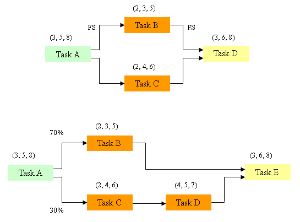Risk management - Nodes and branching networks
Nodes and branching networks
We have seen the above simple network examples before [see simple network].
Nodes
The first has 2, Tasks B and C, both of which must end before Task D can begin.
They complete at a NODE leading to Task D.
Tasks B and C run in parallel and the start of Task D is driven by the longer of Task B or C.
The effect on the uncertainty is governed by the uncertainty in the completion of each of the tasks.
If we have only 2 tasks (as here with Tasks B and C) we might have a probability of completing each of them of 98%.
At this value we would be very confident that Task B will complete. Similarly, we would be confident that Task C would complete.
However, the risk to beginning Task D is dependent upon both and would be 0.98 x 0.98 = 0.96, still high.
But what if there were more than 2 tasks running in parallel prior to the start of Task D?
Let us look at values for more than 2 tasks with each having a probability of 98% to complete.
3 Tasks = 0.98 x 0.98 x 0.98 = 0.94
5 Tasks = 0.98 x 0.98 x 0.98 x 0.98 x 0.98 = 0.90
10 Tasks = 0.98 x 0.98 x 0.98 x 0.98 x 0.98 x 0.98 x 0.98 x 0.98 x 0.98 x 0.98 = 0.82
The degree of uncertainty starts to increase quickly.
Had the probability of completion for each task been 95% we would get:
2 Tasks = 0.95 x 0.95 = 0.90
3 Tasks = 0.95 x 0.95 x 0.95 = 0.86
5 Tasks = 0.95 x 0.95 x 0.95 x 0.95 x 0.95 = 0.77
10 Tasks = 0.95 x 0.95 x 0.95 x 0.95 x 0.95 x 0.95 x 0.95 x 0.95 x 0.95 x 0.95 = 0.60
So, we can see that NODES can have a dramatic effect on the uncertainty in the schedule.
They accentuate a ‘weak link in the chain’.
Branching
The effect of branching is how you may wish to set your total duration [see branching networks].



